Experimental Investigation on the Influence of Different Reservoir Water Levels on Landslide-Induced Impulsive Waves
Abstract
:1. Introduction
2. Overview of the WJS Landslide
3. Methodology
3.1. Geomechanical Model Experimental Methodology and Experimental Design
3.2. Testing Techniques for the Spatiotemporal Distribution of Landslide-Generated Waves
4. Spatiotemporal Evolution of Landslide-Generated Waves Under Different Water Level Conditions
4.1. Movement Characteristics of Landslide-Generated Waves
4.2. Characteristics of the Sliding Movement of the Landslide Mass
- Slow acceleration stage: During this stage, the gravitational potential energy of the landslide mass begins to gradually be converted into kinetic energy. As a large amount of sliding material breaks away from the shear zone, the landslide mass starts to accelerate slowly along the sliding zone. The acceleration in this stage is relatively gentle, mainly driven by the release of gravitational potential energy. At this time, the movement of the landslide mass is mainly influenced by gravity, and other forces (such as frictional force, water resistance, etc.) have not yet significantly exerted their influence.
- Acceleration Phase: During this phase, the potential energy of the landslide mass is almost completely converted into kinetic energy. Under the combined action of gravity, friction, buoyancy, and water resistance, the landslide mass continues to move forward rapidly. Despite the influence of various forces, gravity remains the main driving force for the acceleration of the landslide mass. At this time, the speed of the landslide mass reaches its maximum value and the movement is the most intense.
- Rapid Deceleration Phase: In the final stage, the landslide mass decelerates rapidly under the combined effect of frictional resistance and water resistance, eventually coming to a stop. As the speed of the landslide mass decreases, its kinetic energy gradually transforms into other forms of energy, such as thermal energy and wave energy. A part of the landslide mass will impact the riverbed, causing topographic changes, while the remaining part will accumulate at the lower end of the landslide mass, forming new landform features.
4.3. First Wave Height and Opposite Shore Climb of Near-Field Landslide-Generated Waves
4.4. Wave Propagation Characteristics Along the Flow Path
4.5. Climbing Height at XBL Residential Area
5. Conclusions
- The generation, propagation, and climbing process of landslide-generated surges involves complex water–soil interaction and wave dynamics problems. This paper only considers the influence of a single variable (water level) on the spatiotemporal distribution of surges, and does not deeply explore other effects related to the water level effect, such as volume effect and velocity effect. Future research should further expand to cover these more complex factors.
- The test conditions of this paper only designed three water level conditions, and the influence of water level factors on the spatiotemporal distribution of surges generated by the Wangjiashan landslide is not sufficient. In particular, the critical water level cannot be determined. In subsequent research, it is recommended to design more gradient water level conditions to enhance the rigor and typicality of the content, and further analyze the influence of subtle changes in water level on the spatiotemporal evolution of surges.
- The physical model test can simulate the surge phenomenon after the landslide enters the water in the laboratory conditions, and directly display the formation, propagation, and climbing process of landslide-generated surges. By observing the water flow and wave motion in the model, the dynamic behavior of surges can be intuitively understood, and real visual effects and data support for further research are provided.
- Water level changes have a significant impact on the generation, propagation, and climbing of landslide-generated surges, and are important factors for predicting and evaluating the characteristics of surges. Water level, as one of the key parameters affecting the characteristics of landslide-generated surges, directly determines the energy transfer, wave height changes, and climbing ability of surges. Overall, the influence of water level on wave climbing is a non-linear relationship. With the increase in water level, the frictional resistance of waves in the propagation process decreases, energy loss reduces, and the kinetic energy and climbing ability of waves increase. Under high water level conditions, waves can more effectively convert kinetic energy into potential energy, resulting in higher wave peaks and greater climbing distances. However, when the water level exceeds a certain critical level, the depth and volume of the water body become too large, which may lead to energy dispersion and weaken the climbing effect of surges.
- Taking the Wangjiashan landslide in the Baihetan Reservoir area as an example, under three different water level conditions, the maximum climbing elevation of the potential surge impact waves generated by the Wangjiashan landslide in the Xiangbiling residential area is 827.25 m, which is lower than the elevation of 827.5 m of the Xiangbiling residential area. Within the water level scheduling range, the potential surge wave amplitude in the Xiangbiling residential area is within the safety margin.
- This study provides key experimental data and theoretical insights for the formation and propagation mechanism of landslide-generated surges, and offers a scientific basis and support for the risk prediction and prevention of landslide-generated surges.
Author Contributions
Funding
Data Availability Statement
Acknowledgments
Conflicts of Interest
References
- Tang, H.M.; Wasowski, J.; Juang, C.H. Geohazards in the three Gorges Reservoir Area, China Lessons learned from decades of research. Eng. Geol. 2019, 261, 16. [Google Scholar] [CrossRef]
- Zhang, Y.G.; Zhang, Z.; Xue, S.; Wang, R.J.; Xiao, M. Stability analysis of a typical landslide mass in the Three Gorges Reservoir under varying reservoir water levels. Environ. Earth Sci. 2020, 79, 14. [Google Scholar] [CrossRef]
- Zhang, S.L.; Yin, Y.P.; Hu, X.W.; Wang, W.P.; Zhang, N.; Zhu, S.N.; Wang, L.Q. Dynamics and emplacement mechanisms of the successive Baige landslides on the Upper Reaches of the Jinsha River, China. Eng. Geol. 2020, 278, 13. [Google Scholar] [CrossRef]
- Fu, Z.Y.; Li, D.Q.; Wang, S.; Zhang, L.M.; Du, W.Q. Causes of episodic movement of the Baijiabao landslide based on multiple-time scale analysis. Landslides 2024, 21, 1069–1082. [Google Scholar] [CrossRef]
- Dai, Z.; Zhang, Y.; Zhang, C.; Luo, J.; Yao, W. Interpreting the Influence of Reservoir Water Level Fluctuation on the Seepage and Stability of an Ancient Landslide in the Three Gorges Reservoir Area: A Case Study of the Outang Landslide. Geotech. Geol. Eng. 2022, 40, 4551–4561. [Google Scholar] [CrossRef]
- Zhang, X.; Tu, G.X.; Luo, Q.F.; Tang, H.; Zhang, Y.L.; Li, A.R. Failure mechanism of a large-scale composite deposits caused by the water level increases. J. Mt. Sci. 2023, 20, 1369–1384. [Google Scholar] [CrossRef]
- Hou, T.-S.; Xu, G.-L.; Zhang, D.-Q.; Liu, H.-Y. Stability analysis of Gongjiacun landslide in the three Gorges Reservoir area under the action of reservoir water level fluctuation and rainfall. Nat. Hazards 2022, 114, 1647–1683. [Google Scholar] [CrossRef]
- Cheng, Z.; Liu, S.; Fan, X.; Shi, A.; Yin, K. Deformation behavior and triggering mechanism of the Tuandigou landslide around the reservoir area of Baihetan hydropower station. Landslides 2023, 20, 1679–1689. [Google Scholar] [CrossRef]
- Sun, G.; Zheng, H.; Tang, H.; Dai, F. Huangtupo landslide stability under water level fluctuations of the Three Gorges reservoir. Landslides 2016, 13, 1167–1179. [Google Scholar] [CrossRef]
- Yi, X.; Feng, W.; Li, B.; Yin, B.; Dong, X.; Xin, C.; Wu, M. Deformation characteristics, mechanisms, and potential impulse wave assessment of the Wulipo landslide in the Baihetan reservoir region, China. Landslides 2023, 20, 615–628. [Google Scholar] [CrossRef]
- Li, Z.-H.; Jiang, N.; Shi, A.-C.; Zhao, L.-Y.; Xian, Z.; Luo, X.-L.; Li, H.-B.; Zhou, J.-W. Reservoir landslide monitoring and mechanism analysis based on UAV photogrammetry and sub-pixel offset tracking: A case study of Wulipo landslide. Front. Earth Sci. 2024, 11, 1333815. [Google Scholar] [CrossRef]
- Zhou, C.; Yin, K.L.; Cao, Y.; Ahmed, B. Application of time series analysis and PSO-SVM model in predicting the Bazimen landslide in the Three Gorges Reservoir, China. Eng. Geol. 2016, 204, 108–120. [Google Scholar] [CrossRef]
- Huang, R.Q.; Li, W.L. Development and distribution of geohazards triggered by the 5.12 Wenchuan Earthquake in China. Sci. China Ser. E-Technol. Sci. 2009, 52, 810–819. [Google Scholar] [CrossRef]
- Sun, L.; Li, C.; Shen, F.; Zhang, H. Reactivation mechanism and evolution characteristics of water softening-induced reservoir-reactivated landslides: A case study for the Three Gorges Reservoir Area, China. Bull. Eng. Geol. Environ. 2023, 82, 66. [Google Scholar] [CrossRef]
- Panizzo, A.; De Girolamo, P.; Di Risio, M.; Maistri, A.; Petaccia, A. Great landslide events in Italian artificial reservoirs. Nat. Hazards Earth Syst. Sci. 2005, 5, 733–740. [Google Scholar] [CrossRef]
- Boon, C.W.; Houlsby, G.T.; Utili, S. New insights into the 1963 Vajont slide using 2D and 3D distinct-element method analyses. Geotechnique 2014, 64, 800–816. [Google Scholar] [CrossRef]
- Wolter, A.; Stead, D.; Ward, B.C.; Clague, J.J.; Ghirotti, M. Engineering geomorphological characterisation of the Vajont Slide, Italy, and a new interpretation of the chronology and evolution of the landslide. Landslides 2016, 13, 1067–1081. [Google Scholar] [CrossRef]
- Barla, G.; Paronuzzi, P. The 1963 Vajont Landslide: 50th Anniversary. Rock Mech. Rock Eng. 2013, 46, 1267–1270. [Google Scholar] [CrossRef]
- Tang, W.Z.; Li, Z.Y.; Qiang, M.S.; Wang, S.L.; Lu, Y.M. Risk management of hydropower development in China. Energy 2013, 60, 316–324. [Google Scholar] [CrossRef]
- Chen, S.; Shi, A.; Xu, W.; Yan, L.; Wang, H.; Tian, L.; Xie, W.-C. Numerical investigation of landslide-induced waves: A case study of Wangjiashan landslide in Baihetan Reservoir, China. Bull. Eng. Geol. Environ. 2023, 82, 110. [Google Scholar] [CrossRef]
- Fang, K.; Tang, H.; Li, C.; Su, X.; An, P.; Sun, S. Centrifuge modelling of landslides and landslide hazard mitigation: A review. Geosci. Front. 2023, 14, 101493. [Google Scholar] [CrossRef]
- Mergili, M.; Frank, B.; Fischer, J.T.; Huggel, C.; Pudasaini, S.P. Computational experiments on the 1962 and 1970 landslide events at Huascaran (Peru) with r.avaflow: Lessons learned for predictive mass flow simulations. Geomorphology 2018, 322, 15–28. [Google Scholar] [CrossRef]
- Huang, B.; Yin, Y.; Liu, G.; Chen, X.; Wang, S. A comparative study on the physical prototype test and numerical simulation of the swell of the Gongjiafang landslide in the Three Gorges Reservoir area. Rock. Mech. Eng. J. 2014, 2677–2684. [Google Scholar] [CrossRef]
- Shi, C.; An, Y.; Yang, J. A SPH based numerical method of landslide induced impulse wave and its application on Huangtian landslide event. Sci. Sin. Phys. Mech. Astron. 2015, 45, 104706. [Google Scholar]
- Sun, G.; Yang, Y.; Jiang, W.; Zheng, H. Effects of an increase in reservoir drawdown rate on bank slope stability: A case study at the Three Gorges Reservoir, China. Eng. Geol. 2017, 221, 61–69. [Google Scholar] [CrossRef]
- Luo, S.L.; Huang, D.; Peng, J.B.; Tomás, R. Influence of permeability on the stability of dual-structure landslide with different deposit-bedding interface morphology: The case of the three Gorges Reservoir area, China. Eng. Geol. 2022, 296, 22. [Google Scholar] [CrossRef]
- Huang, X.; Guo, F.; Deng, M.; Yi, W.; Huang, H. Understanding the deformation mechanism and threshold reservoir level of the floating weight-reducing landslide in the Three Gorges Reservoir Area, China. Landslides 2020, 17, 2879–2894. [Google Scholar] [CrossRef]
- Fell, R.; Cororninas, J.; Bonnard, C.; Cascini, L.; Leroi, E.; Savage, W.Z.; JTC-1 Joint Technical Committee on Landslides and Engineered Slopes. Guidelines for landslide susceptibility, hazard and risk-zoning for land use planning. Eng. Geol. 2008, 102, 85–98. [Google Scholar] [CrossRef]
- Dai, F.C.; Lee, C.F.; Ngai, Y.Y. Landslide risk assessment and management: An overview. Eng. Geol. 2002, 64, 65–87. [Google Scholar] [CrossRef]
- van Westen, C.J.; Castellanos, E.; Kuriakose, S.L. Spatial data for landslide susceptibility, hazard, and vulnerability assessment: An overview. Eng. Geol. 2008, 102, 112–131. [Google Scholar] [CrossRef]
- Ataie-Ashtiani, B.; Nik-Khah, A. Impulsive waves caused by subaerial landslides. Environ. Fluid Mech. 2008, 8, 263–280. [Google Scholar] [CrossRef]
- Yavari-Ramshe, S.; Ataie-Ashtiani, B. On the effects of landslide deformability and initial submergence on landslide-generated waves. Landslides 2019, 16, 37–53. [Google Scholar] [CrossRef]
- Huang, B.; Yin, Y.; Li, R.; Zhang, P.; Qin, Z.; Li, Y.; Cheng, S.; Li, Q.; Xu, K. Three-dimensional experimental investigation on hazard reduction of landslide-generated impulse waves in the Baihetan Reservoir, China. Landslides 2023, 20, 2017–2028. [Google Scholar] [CrossRef]
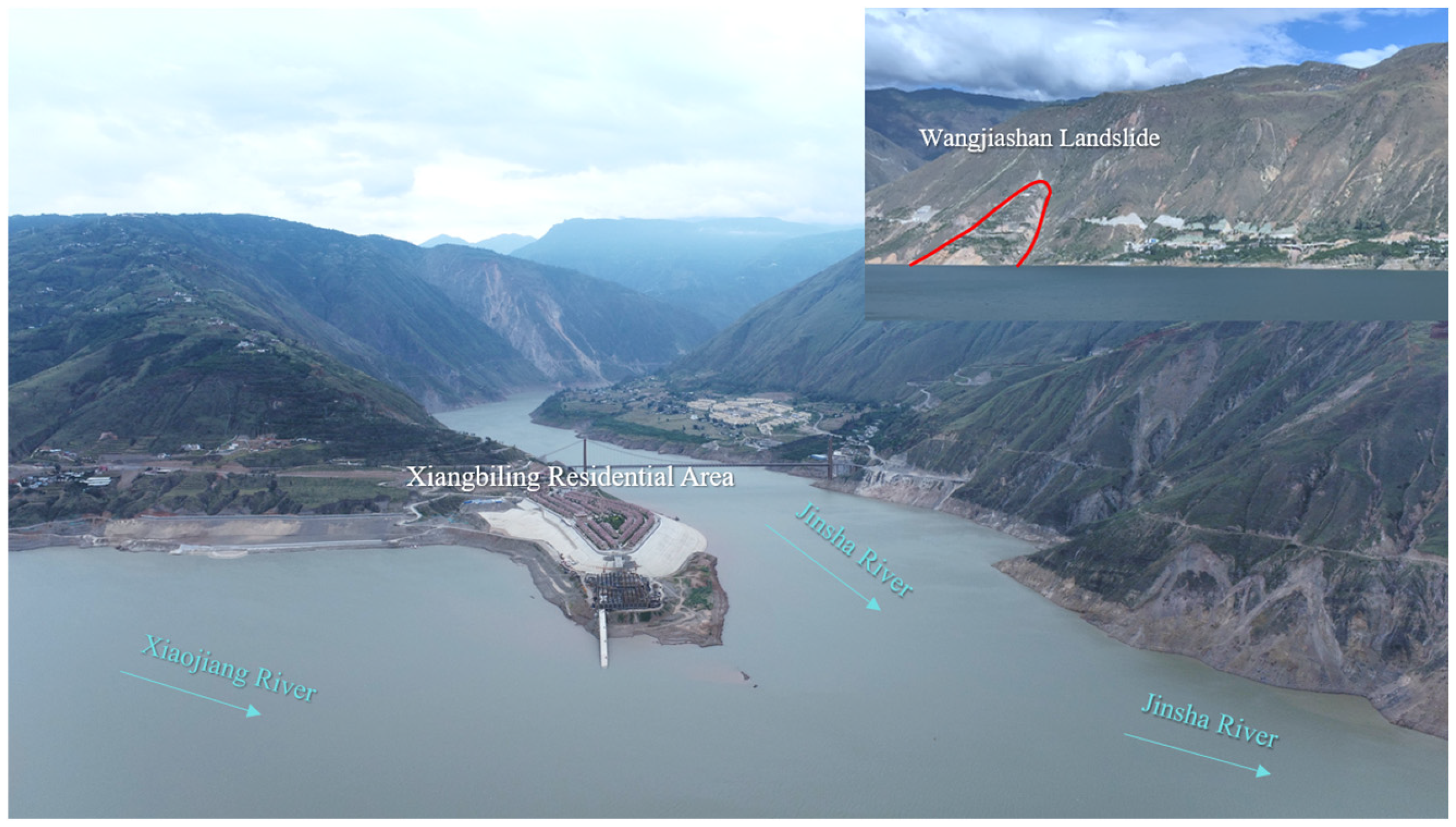
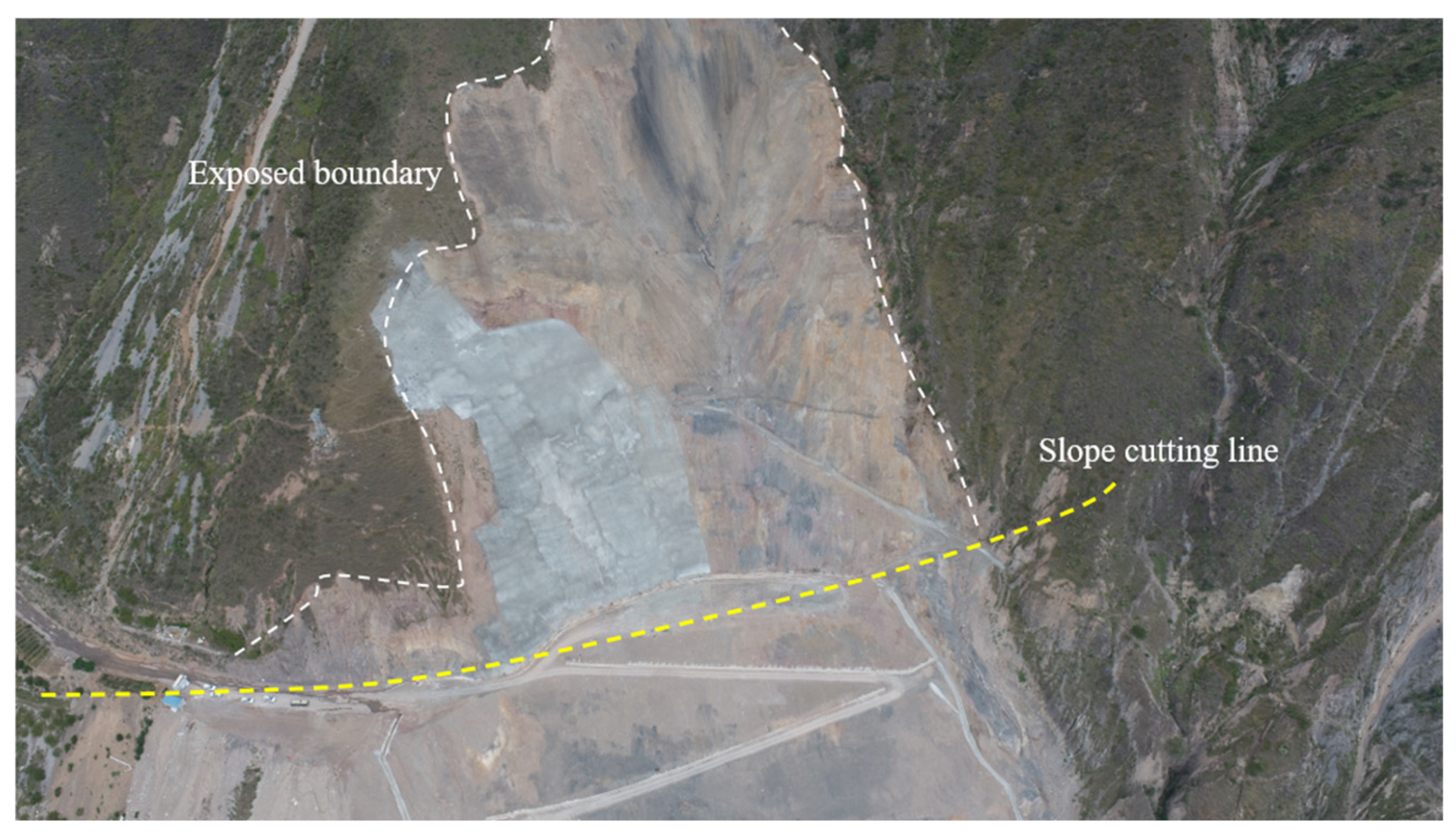
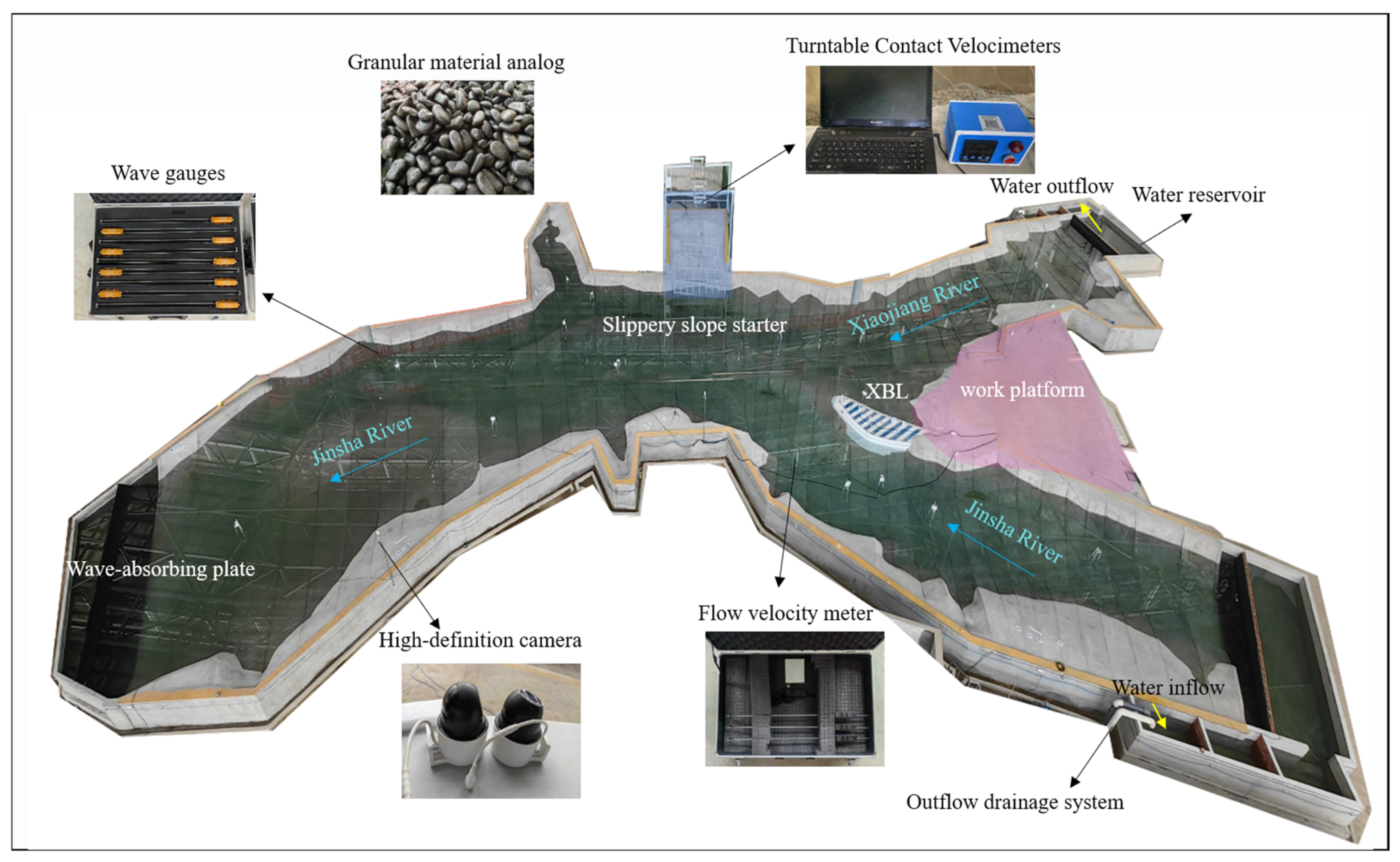
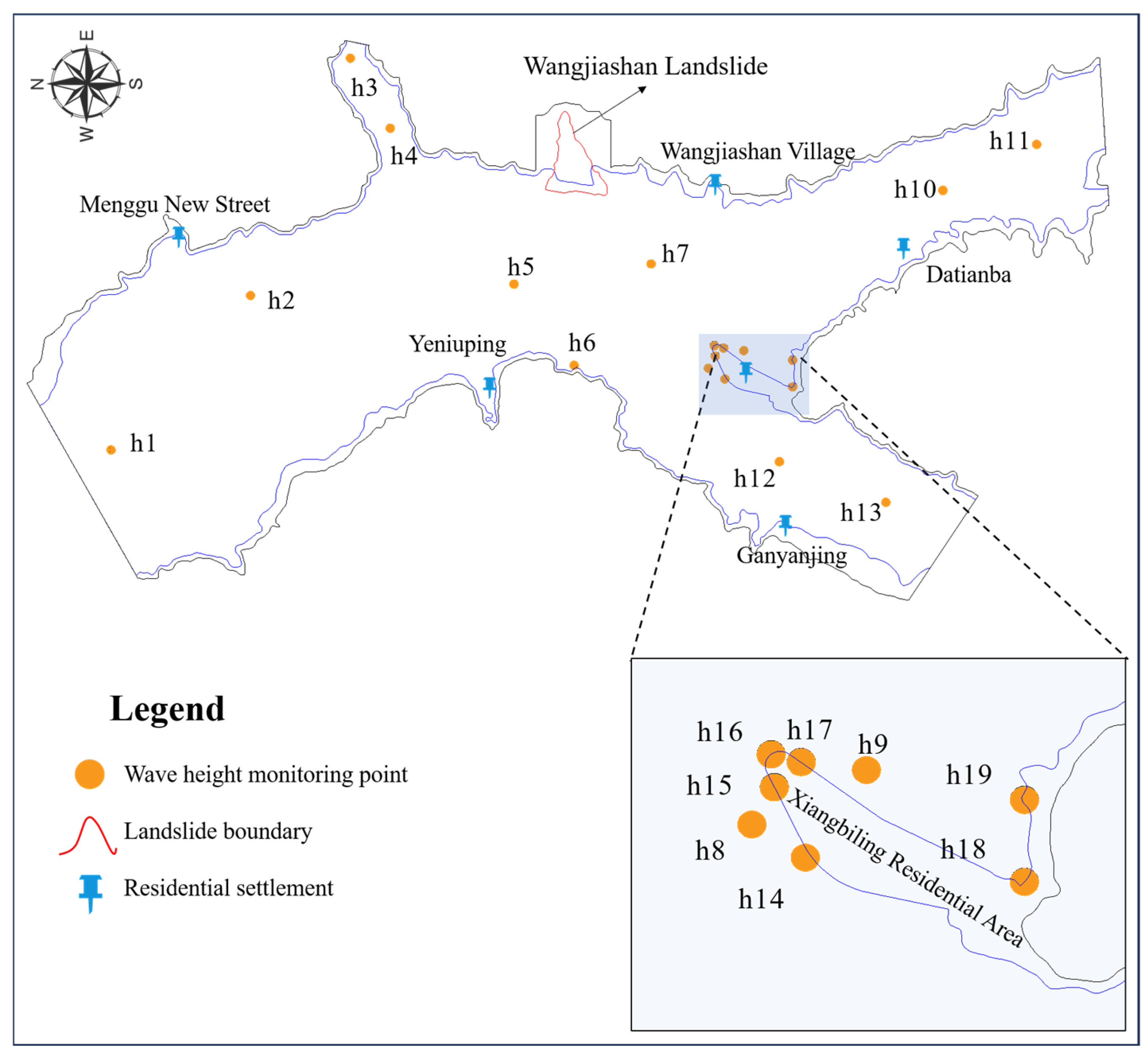

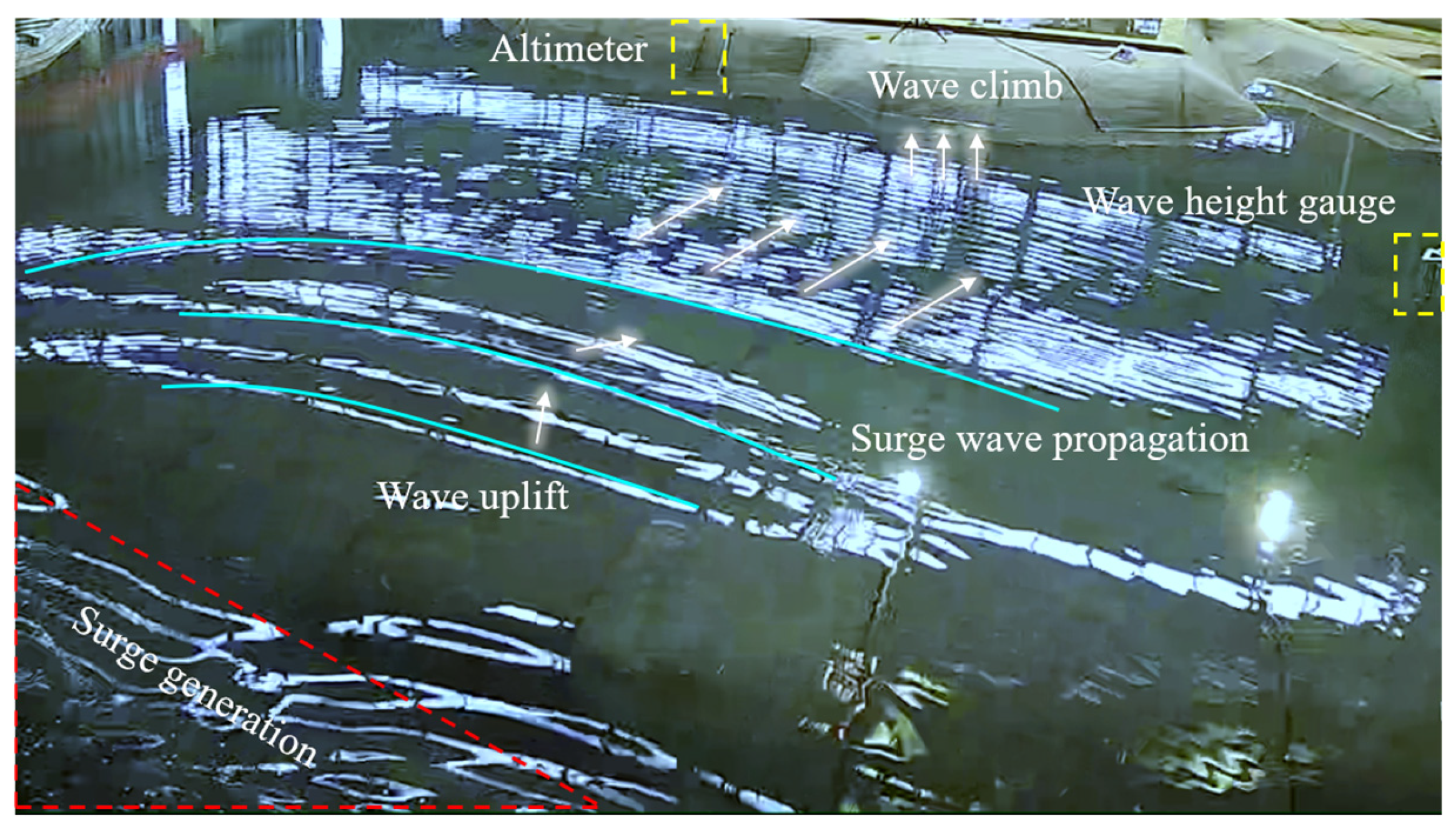
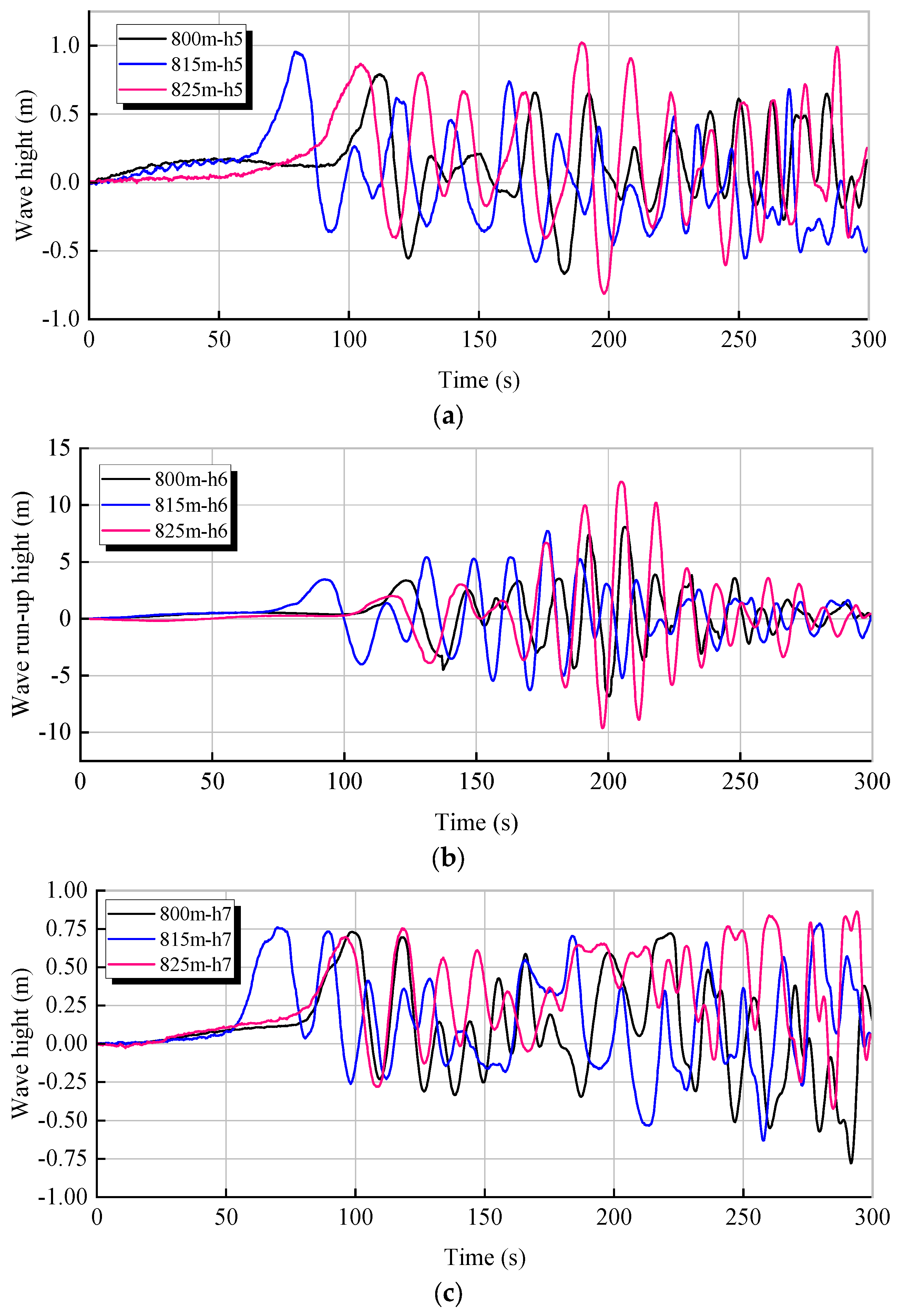


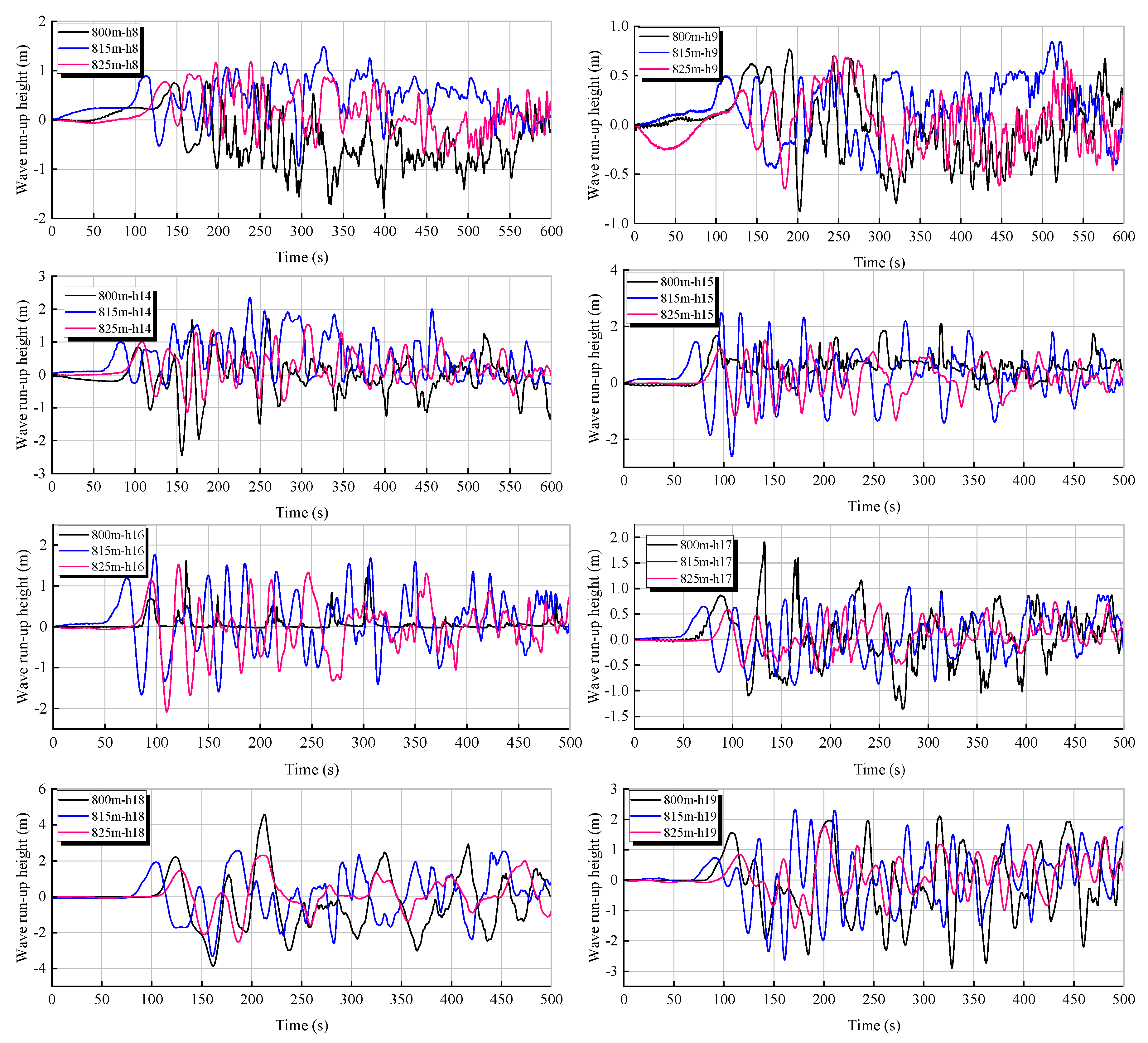
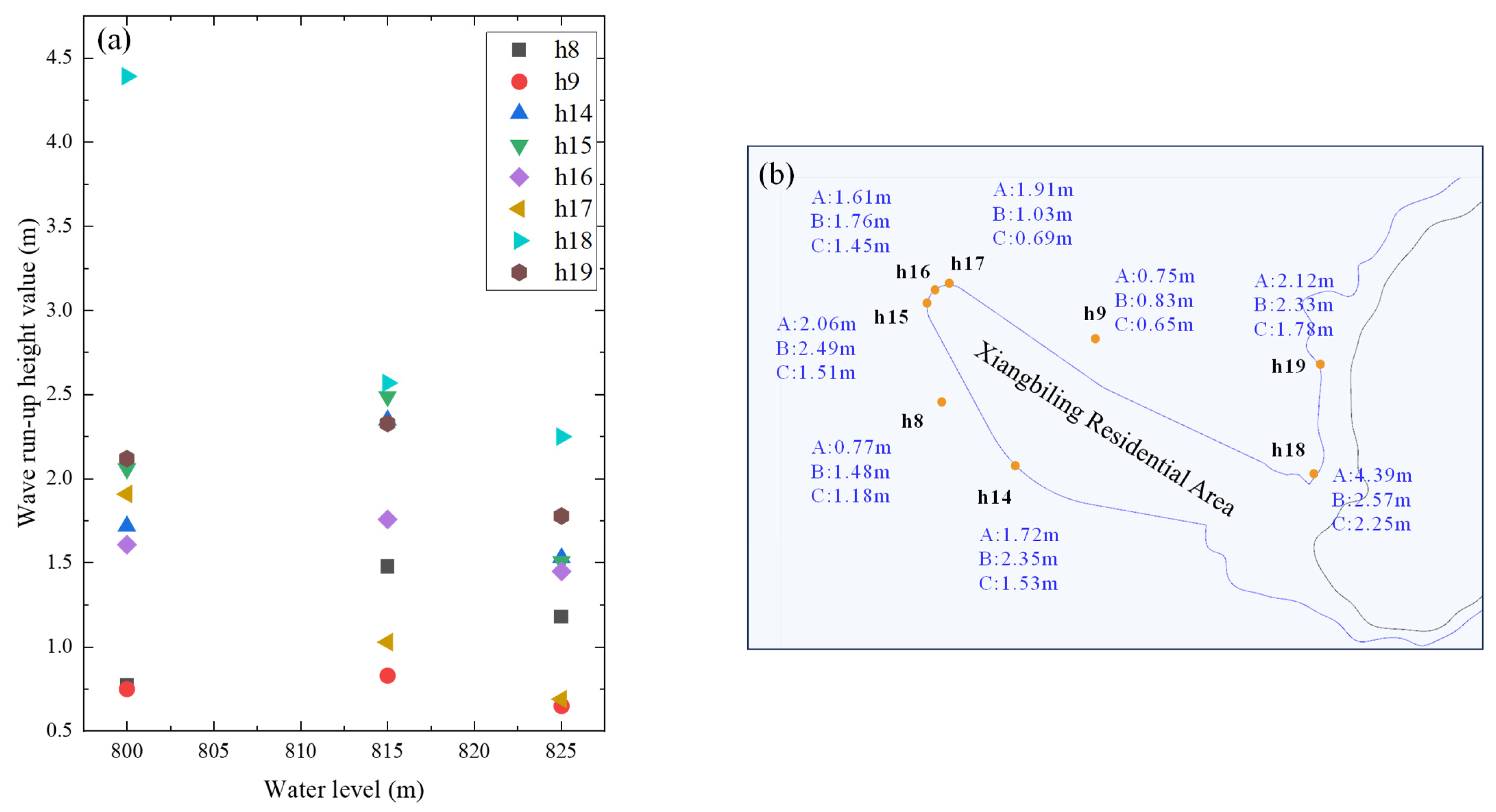
Disclaimer/Publisher’s Note: The statements, opinions and data contained in all publications are solely those of the individual author(s) and contributor(s) and not of MDPI and/or the editor(s). MDPI and/or the editor(s) disclaim responsibility for any injury to people or property resulting from any ideas, methods, instructions or products referred to in the content. |
© 2025 by the authors. Licensee MDPI, Basel, Switzerland. This article is an open access article distributed under the terms and conditions of the Creative Commons Attribution (CC BY) license (https://creativecommons.org/licenses/by/4.0/).
Share and Cite
Shi, A.; Lei, J.; Tian, L.; Lyu, C.; Mao, P. Experimental Investigation on the Influence of Different Reservoir Water Levels on Landslide-Induced Impulsive Waves. Water 2025, 17, 890. https://doi.org/10.3390/w17060890
Shi A, Lei J, Tian L, Lyu C, Mao P. Experimental Investigation on the Influence of Different Reservoir Water Levels on Landslide-Induced Impulsive Waves. Water. 2025; 17(6):890. https://doi.org/10.3390/w17060890
Chicago/Turabian StyleShi, Anchi, Jie Lei, Lei Tian, Changhao Lyu, and Pengchao Mao. 2025. "Experimental Investigation on the Influence of Different Reservoir Water Levels on Landslide-Induced Impulsive Waves" Water 17, no. 6: 890. https://doi.org/10.3390/w17060890
APA StyleShi, A., Lei, J., Tian, L., Lyu, C., & Mao, P. (2025). Experimental Investigation on the Influence of Different Reservoir Water Levels on Landslide-Induced Impulsive Waves. Water, 17(6), 890. https://doi.org/10.3390/w17060890





